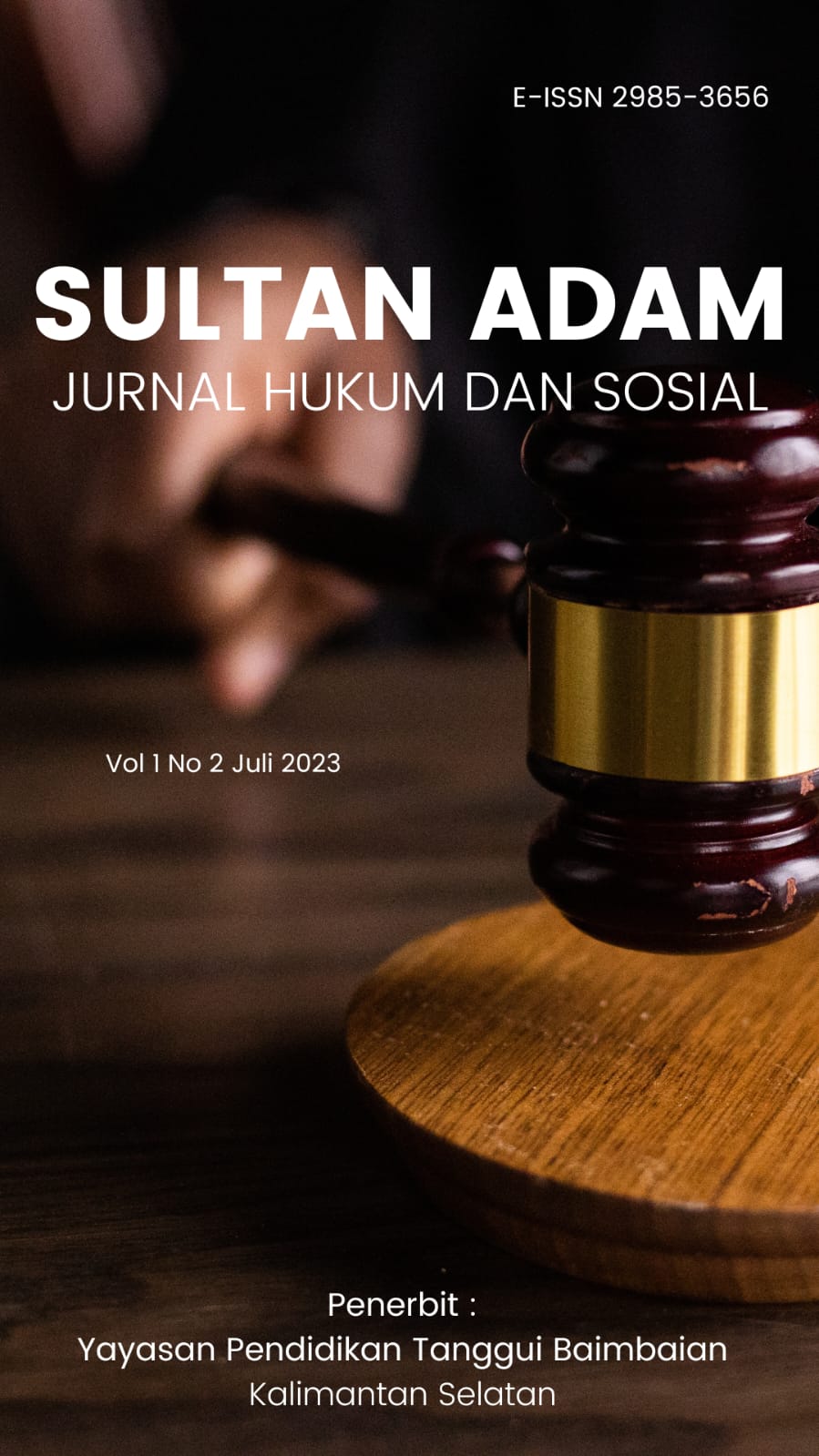PENGARUH PERKEMBANGAN TEKNOLOGI TERHADAP PERLINDUNGAN PRIVASI DALAM HUKUM PERDATA
Kata Kunci:
Teknologi Digital, Perlindungan Privasi, Hukum PerdataAbstrak
Perkembangan teknologi informasi dan komunikasi telah mengubah cara manusia berinteraksi dan mengakses informasi. Namun, perkembangan ini juga menimbulkan tantangan baru dalam hal melindungi privasi individu. Penelitian ini bertujuan untuk menganalisis pengaruh perkembangan teknologi terhadap perlindungan privasi dalam hukum perdata.
Penelitian ini menggunakan pendekatan kualitatif dengan metode studi kepustakaan dan analisis isi untuk mengumpulkan data dan menganalisis argumen yang berkaitan dengan perlindungan privasi dalam hukum perdata.
Beberapa aspek yang dibahas dalam penelitian ini meliputi definisi privasi, evolusi teknologi informasi dan komunikasi, perubahan hukum perdata terkait perlindungan privasi, dan tantangan yang dihadapi dalam mengadaptasi hukum perdata dengan perkembangan teknologi. Hasil penelitian menunjukkan bahwa perkembangan teknologi telah mengubah lanskap privasi dalam konteks hukum perdata. Munculnya internet, media sosial, dan perangkat mobile telah memperluas kemampuan individu untuk berbagi informasi secara luas, yang pada gilirannya meningkatkan risiko pelanggaran privasi. Di sisi lain, perkembangan teknologi juga memberikan peluang baru untuk melindungi privasi, seperti enkripsi data dan keamanan siber. Namun, penelitian ini juga mengidentifikasi beberapa tantangan dalam melindungi privasi dalam hukum perdata di era teknologi yang semakin maju. Beberapa tantangan utama meliputi kesenjangan antara perkembangan teknologi dan kebijakan hukum, masalah keamanan data, dan ketidakjelasan batas privasi dalam lingkungan digital.
Referensi
Acquisti, A., & Grossklags, J. (2005). Privacy and rationality in individual decision making. IEEE Security & Privacy, 3(1), 26-33.
Acquisti, A., & Grossklags, J. (2018). What can economics tell us about privacy? Journal of Economic Literature, 56(3), 399-456.
Bassiouni, M. C. (Ed.). (2016). Global Privacy Protection: The First Generation. Eleven International Publishing.
Bernal, P. (2016). Big data and the law: Towards principles for protecting patient autonomy and confidentiality. International Journal of Law and Information Technology, 24(1), 84-103.
Bernal, P. (2019). Data Protection and Privacy Law: A Comparative Analysis. Edward Elgar Publishing.
Bygrave, L. A. (2018). Data privacy law: an international perspective. Oxford University Press.
Cavoukian, A., & Tapscott, D. (2017). Who Owns the Data? New Rights for Data Ownership. Retrieved from https://www.weforum.org/agenda/2017/02/who-owns-the-data-new-rights-for-data-ownership
Clarke, R. (2009). Privacy Impact Assessments and the Design of Privacy-friendly Systems. Privacy Law & Policy Reporter, 15(2), 35–37.
De Hert, P., & Gutwirth, S. (Eds.). (2011). Privacy and Data Protection Impact Assessments. Springer Science & Business Media.
De Hert, P., & Papakonstantinou, V. (2016). The New General Data Protection Regulation: Still a Sound System for the Protection of Individuals? Computer Law & Security Review, 32(2), 179–194.
European Commission. (2018). General Data Protection Regulation (GDPR). Retrieved from https://gdpr.eu/
European Data Protection Board. (2020). Guidelines 07/2020 on the concepts of controller and processor in the GDPR (Version 1.0). Retrieved from https://edpb.europa.eu/sites/edpb/files/consultation/edpb_guidelines_202007_controllerprocessor_v1.1_en.pdf
European Union Agency for Fundamental Rights. (2019). Handbook on European data protection law - 2018 edition.
Greenleaf, G. W. (2017). Global Data Privacy Laws 2017. Privacy Laws & Business International Report, 148, 13–17.
Greenwald, G. (2014). No Place to Hide: Edward Snowden, the NSA, and the U.S. Surveillance State. Metropolitan Books.
Hildebrandt, M., & Koops, B.-J. (2010). The Challenges of Ambient Law and Legal Protection in the Profiling Era. The Modern Law Review, 73(3), 428–460.
Kang, J. (2012). Information Privacy in Cyberspace Transactions. Columbia Law Review, 102(4), 1187–1284.
Kosseff, J. (2017). Cybersecurity Law. Wiley.
Kuner, C., & Bygrave, L. A. (Eds.). (2018). The European Union general data protection regulation: A commentary. Oxford University Press.
Langheinrich, M. (2001). Privacy as a means of consumer protection. 3rd International Workshop on Advanced Issues of E-Commerce and Web-Based Information Systems.
Nissenbaum, H. (2010). Privacy in context: Technology, policy, and the integrity of social life. Stanford University Press.
Reidenberg, J. R. (2015). Privacy and technology. Annual Review of Law and Social Science, 11, 383-399.
Ryan, C. (2019). The European Union General Data Protection Regulation: A Practical Guide. McFarland.
Schwartz, P. M., & Solove, D. J. (2011). The PII Problem: Privacy and a New Concept of Personally Identifiable Information. NYU Law Review, 86(6), 1814–1901.
Šimović, G., & Kierkegaard, S. (2019). Personal Data Protection in the EU: Do the Rules Meet the Challenges of Artificial Intelligence and Big Data? Computer Law & Security Review, 35(5), 589–604.
Solove, D. J. (2006). A taxonomy of privacy. University of Pennsylvania Law Review, 154(3), 477-560.
Solove, D. J. (2008). Understanding privacy. Harvard University Press.
Solove, D. J. (2011). Privacy self-management and the consent dilemma. Harvard Law Review, 126(7), 1880-1903.
Solove, D. J. (2011). Understanding privacy. Harvard University Press.
Solove, D. J. (2013). Privacy in the Age of Big Data: Recognizing the Importance of Context. Columbia Law Review, 114(7), 1613–1673.
Solove, D. J. (2013). Privacy in the Age of Big Data: Recognizing the Potential for Abuses. Harvard Law Review, 127(7), 1961–2012.
Solove, D. J. (2013). Understanding Privacy. Harvard University Press.
Van Den Hoven, J., & Weckert, J. (Eds.). (2017). Information Technology and Moral Philosophy. Cambridge University Press.
van der Hof, S., Koops, B.-J., & Prins, C. (2014). Unravelling the Gordian Knot of Consent in the GDPR. International Data Privacy Law, 4(3), 165–177.
Warren, S. D., & Brandeis, L. D. (1890). The right to privacy. Harvard Law Review, 4(5), 193-220.
Westin, A. F. (1967). Privacy and freedom. Washington and Lee Law Review, 24(1), 166-206.
World Economic Forum. (2019). Shaping the future of the digital economy and new value creation: Fourth Industrial Revolution for the Earth series.
Yang, C., Fang, W., & Wen, C. (2018). A holistic model for understanding privacy protection behaviors in the era of big data. Computers in Human Behavior, 88, 265-275.











